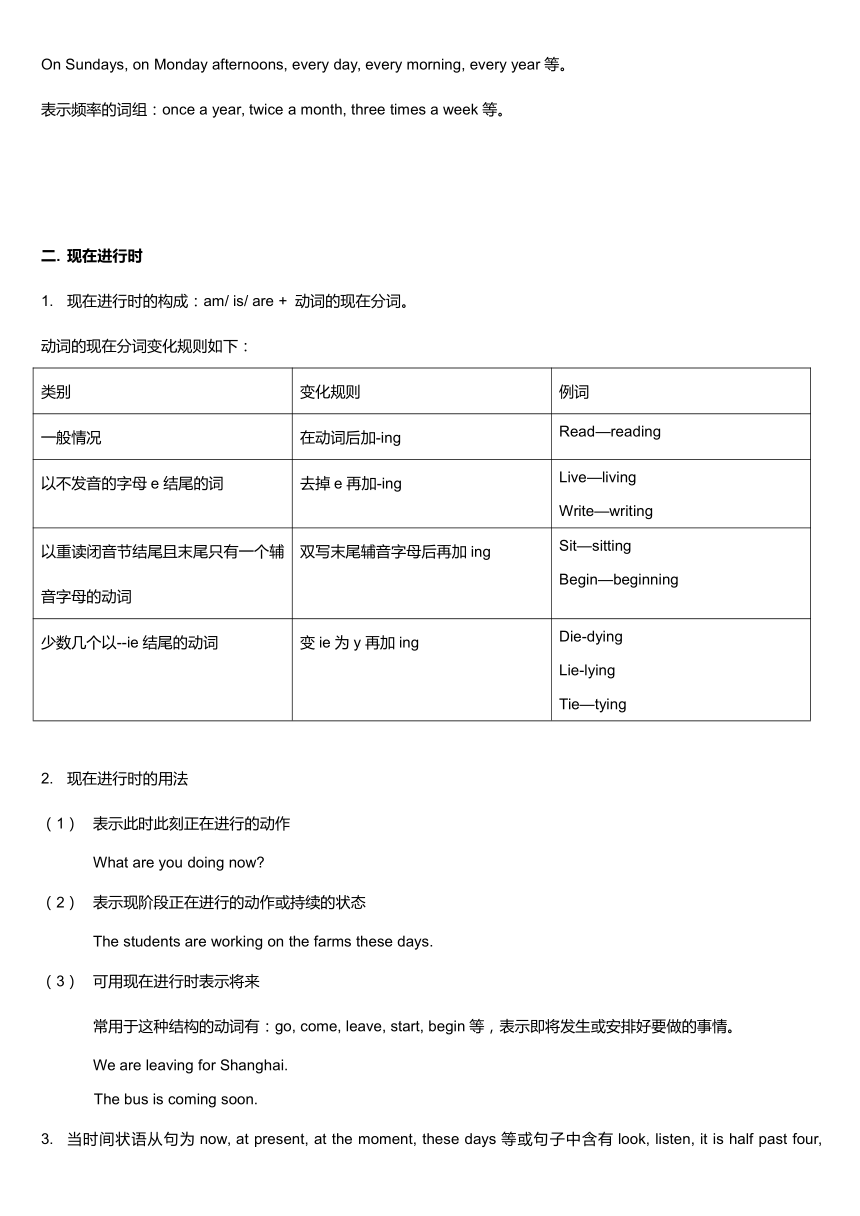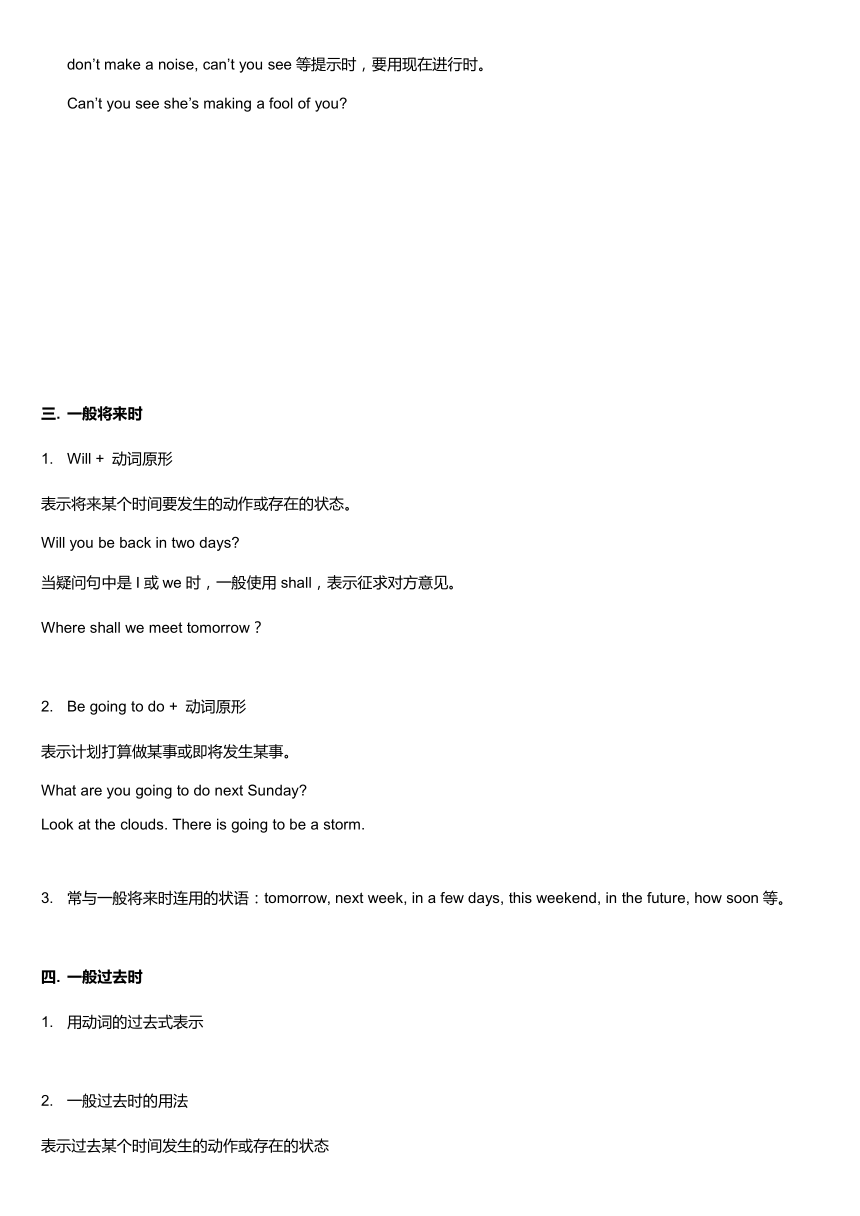谓语动词的时态---中考英语语法讲解
文档属性
| 名称 | 谓语动词的时态---中考英语语法讲解 |

|
|
| 格式 | docx | ||
| 文件大小 | 21.0KB | ||
| 资源类型 | 教案 | ||
| 版本资源 | 牛津译林版 | ||
| 科目 | 英语 | ||
| 更新时间 | 2024-07-30 11:51:41 | ||
图片预览



文档简介
谓语动词的时态
动词的时态和语态
常考时态:一般现在时,现在进行时,现在完成时,一般过去时,过去进行时,一般将来时
了解:过去完成时
一般现在时
一般现在时主要用动词原形表示,如果主语是第三人称单数,则用动词的第三人称单数形式。动词的第三人称单数的变化规则如下:
类别 变化规则 例词
一般情况 后加-s Run—runs Like—likes
以ch, sh, s, o, x结尾的动词 后加-es Teach--teaches Wash--washes Go--goes Pass--passes
以辅音字母加y结尾的动词 将y变i再加-es Study—studies Carry--carries
2. 一般现在时的用法:
(1) 表示经常性或习惯性的动作或存在的状态
I often take a bus to school.
(2) 表示客观事实或普遍真理
The earth is round.
(3) 当主句为一般将来时时,在if, as soon as, until, when等引导的条件。时间状语从句中,用一般现在时表示将来。
If it doesn’t rain tomorrow, we will go to the zoo.
When we meet next time, I will discuss the matter with you.
(4) 常与一般现在时连用的状语
频度副词:always, usually, often, sometimes, never等。
On Sundays, on Monday afternoons, every day, every morning, every year等。
表示频率的词组:once a year, twice a month, three times a week等。
现在进行时
现在进行时的构成:am/ is/ are + 动词的现在分词。
动词的现在分词变化规则如下:
类别 变化规则 例词
一般情况 在动词后加-ing Read—reading
以不发音的字母e结尾的词 去掉e再加-ing Live—living Write—writing
以重读闭音节结尾且末尾只有一个辅音字母的动词 双写末尾辅音字母后再加ing Sit—sitting Begin—beginning
少数几个以--ie结尾的动词 变ie为y再加ing Die-dying Lie-lying Tie—tying
现在进行时的用法
表示此时此刻正在进行的动作
What are you doing now
表示现阶段正在进行的动作或持续的状态
The students are working on the farms these days.
可用现在进行时表示将来
常用于这种结构的动词有:go, come, leave, start, begin等,表示即将发生或安排好要做的事情。
We are leaving for Shanghai.
The bus is coming soon.
当时间状语从句为now, at present, at the moment, these days等或句子中含有look, listen, it is half past four, don’t make a noise, can’t you see等提示时,要用现在进行时。
Can’t you see she’s making a fool of you
一般将来时
Will + 动词原形
表示将来某个时间要发生的动作或存在的状态。
Will you be back in two days
当疑问句中是I或we时,一般使用shall,表示征求对方意见。
Where shall we meet tomorrow?
Be going to do + 动词原形
表示计划打算做某事或即将发生某事。
What are you going to do next Sunday
Look at the clouds. There is going to be a storm.
常与一般将来时连用的状语:tomorrow, next week, in a few days, this weekend, in the future, how soon等。
一般过去时
用动词的过去式表示
一般过去时的用法
表示过去某个时间发生的动作或存在的状态
We visited a farm last Sunday.
表示过去的习惯或经常发生的动作。
When I was in the countryside, I often swam/ used to swim in the river.
常与一般过去时连用的状语:last night, yesterday, last week, some years ago, in 1990, in the past, the other day, at that time, just now, before等。
过去进行时
构成:were/ was + 动词的现在分词
过去进行时的用法
表示过去某一时刻或一段时间正在进行的动作
I was reading when my mother came in.
Go, come, leave, arrive, start等动词用在过去进行时中表示过去按计划即将发生的动作。
He was leaving when I arrived.
常和表示过去的时间状语(如then, at that time, at this time yesterday等)
一般过去时和过去进行时的区别
类别 用法说明 例句
一般过去时 一般来说,如果强调过去某个时间或某个班时间段有过某个动作,用一般过去时 I wrote a letter yesterday evening.
过去进行时 如果强调动作在过去某个时间或某段时间内正在进行(是否完成不明确),应用过去进行时。 I was writing a letter yesterday evening.
现在完成时
构成:have/ has + 动词的过去分词
动词的过去式和过去分词的变化
规则变化
类别 变化规则 例词
一般情况 在动词后加-ed Work—worked--worked
以辅音字母y结尾的动词 先将y变成i,再加ed Carry—carried—carried Study—studied--studied
以重读闭音节结尾且末尾只有一个辅音字母的动词 双写末尾辅音字母后再加-ed Stop—stopped—stopped Plan—planned--planned
以不发音的字母e结尾的词 直接加-d Live—lived--lived
不规则变化:背诵课本后的附录
现在完成时的用法
发生在过去或已经完成的某个动作对现在造成的影响或产生的结果
I have lost my key.
--Have you found your lost key yet --No, I haven’t found it yet.
注意:already, yet常和现在完成时连用。Already用于肯定句中。Yet用于疑问句或否定句中,常放在句末。
表示动作或状态在过去已经开始,并持续到现在。也许还要持续下去。常和“for + 段时间” “since+过去的时间点或从句(时态为一般过去时)”连用。其肯定句的动词延续性动词。
Mr. Zhang has taught English for 20 years.
现在完成时中的标志性副词
just,刚刚,常放在动词和过去分词之间。
ever,曾经,用于疑问句或否定句中,放在助动词和过去分词之间。
never,从来没有,常与before连用,多放在助动词和过去分词之间。
before,以前,指过去不确定的某个时候,总放在句末。
I have never heard of this singer before.
延续性动词和非延续性动词在现在完成时中的用法
当与段时间的状语连用时,肯定句中谓语动词必须是延续性动词,非延续性动词在肯定句中不能和表示段时间的状语连用。
I have left hometown for 10 years. X
I have been away from my hometown for 10 years.
非延续性动词和延续性动词的转化。
非延续性动词 延续性动词
Buy have
borrow keep
open Be open
close Be closed
Begin/ start Be on
Come Be here
go Be there
Finish/ end Be over
die Be dead
lose Not have
join Be in/ be a member of
leave Be away (from…)
Arrive/ reach Be in/ at
Catch a cold Have a cold
Fall ill/ fall asleep Be ill/ be asleep
Wake up Be awake
Have been to, have gone to和have been in的区别
Have been to, 去过,已回来
Have gone to, 去了,未回
Have been in, 已在某地(待多久)
现在完成时和一般过去时的区别
现在完成时:侧重于过去的动作对现在造成的影响。
一般过去时:侧重于表示过去的动作,与现在无关。
注意:一般过去时的动作已经在过去完成了;现在完成时有可能在过去完成了有可能还在继续。
I have seen this film already.
I saw this film.
I have waited for him for 2 hours.
动词的时态和语态
常考时态:一般现在时,现在进行时,现在完成时,一般过去时,过去进行时,一般将来时
了解:过去完成时
一般现在时
一般现在时主要用动词原形表示,如果主语是第三人称单数,则用动词的第三人称单数形式。动词的第三人称单数的变化规则如下:
类别 变化规则 例词
一般情况 后加-s Run—runs Like—likes
以ch, sh, s, o, x结尾的动词 后加-es Teach--teaches Wash--washes Go--goes Pass--passes
以辅音字母加y结尾的动词 将y变i再加-es Study—studies Carry--carries
2. 一般现在时的用法:
(1) 表示经常性或习惯性的动作或存在的状态
I often take a bus to school.
(2) 表示客观事实或普遍真理
The earth is round.
(3) 当主句为一般将来时时,在if, as soon as, until, when等引导的条件。时间状语从句中,用一般现在时表示将来。
If it doesn’t rain tomorrow, we will go to the zoo.
When we meet next time, I will discuss the matter with you.
(4) 常与一般现在时连用的状语
频度副词:always, usually, often, sometimes, never等。
On Sundays, on Monday afternoons, every day, every morning, every year等。
表示频率的词组:once a year, twice a month, three times a week等。
现在进行时
现在进行时的构成:am/ is/ are + 动词的现在分词。
动词的现在分词变化规则如下:
类别 变化规则 例词
一般情况 在动词后加-ing Read—reading
以不发音的字母e结尾的词 去掉e再加-ing Live—living Write—writing
以重读闭音节结尾且末尾只有一个辅音字母的动词 双写末尾辅音字母后再加ing Sit—sitting Begin—beginning
少数几个以--ie结尾的动词 变ie为y再加ing Die-dying Lie-lying Tie—tying
现在进行时的用法
表示此时此刻正在进行的动作
What are you doing now
表示现阶段正在进行的动作或持续的状态
The students are working on the farms these days.
可用现在进行时表示将来
常用于这种结构的动词有:go, come, leave, start, begin等,表示即将发生或安排好要做的事情。
We are leaving for Shanghai.
The bus is coming soon.
当时间状语从句为now, at present, at the moment, these days等或句子中含有look, listen, it is half past four, don’t make a noise, can’t you see等提示时,要用现在进行时。
Can’t you see she’s making a fool of you
一般将来时
Will + 动词原形
表示将来某个时间要发生的动作或存在的状态。
Will you be back in two days
当疑问句中是I或we时,一般使用shall,表示征求对方意见。
Where shall we meet tomorrow?
Be going to do + 动词原形
表示计划打算做某事或即将发生某事。
What are you going to do next Sunday
Look at the clouds. There is going to be a storm.
常与一般将来时连用的状语:tomorrow, next week, in a few days, this weekend, in the future, how soon等。
一般过去时
用动词的过去式表示
一般过去时的用法
表示过去某个时间发生的动作或存在的状态
We visited a farm last Sunday.
表示过去的习惯或经常发生的动作。
When I was in the countryside, I often swam/ used to swim in the river.
常与一般过去时连用的状语:last night, yesterday, last week, some years ago, in 1990, in the past, the other day, at that time, just now, before等。
过去进行时
构成:were/ was + 动词的现在分词
过去进行时的用法
表示过去某一时刻或一段时间正在进行的动作
I was reading when my mother came in.
Go, come, leave, arrive, start等动词用在过去进行时中表示过去按计划即将发生的动作。
He was leaving when I arrived.
常和表示过去的时间状语(如then, at that time, at this time yesterday等)
一般过去时和过去进行时的区别
类别 用法说明 例句
一般过去时 一般来说,如果强调过去某个时间或某个班时间段有过某个动作,用一般过去时 I wrote a letter yesterday evening.
过去进行时 如果强调动作在过去某个时间或某段时间内正在进行(是否完成不明确),应用过去进行时。 I was writing a letter yesterday evening.
现在完成时
构成:have/ has + 动词的过去分词
动词的过去式和过去分词的变化
规则变化
类别 变化规则 例词
一般情况 在动词后加-ed Work—worked--worked
以辅音字母y结尾的动词 先将y变成i,再加ed Carry—carried—carried Study—studied--studied
以重读闭音节结尾且末尾只有一个辅音字母的动词 双写末尾辅音字母后再加-ed Stop—stopped—stopped Plan—planned--planned
以不发音的字母e结尾的词 直接加-d Live—lived--lived
不规则变化:背诵课本后的附录
现在完成时的用法
发生在过去或已经完成的某个动作对现在造成的影响或产生的结果
I have lost my key.
--Have you found your lost key yet --No, I haven’t found it yet.
注意:already, yet常和现在完成时连用。Already用于肯定句中。Yet用于疑问句或否定句中,常放在句末。
表示动作或状态在过去已经开始,并持续到现在。也许还要持续下去。常和“for + 段时间” “since+过去的时间点或从句(时态为一般过去时)”连用。其肯定句的动词延续性动词。
Mr. Zhang has taught English for 20 years.
现在完成时中的标志性副词
just,刚刚,常放在动词和过去分词之间。
ever,曾经,用于疑问句或否定句中,放在助动词和过去分词之间。
never,从来没有,常与before连用,多放在助动词和过去分词之间。
before,以前,指过去不确定的某个时候,总放在句末。
I have never heard of this singer before.
延续性动词和非延续性动词在现在完成时中的用法
当与段时间的状语连用时,肯定句中谓语动词必须是延续性动词,非延续性动词在肯定句中不能和表示段时间的状语连用。
I have left hometown for 10 years. X
I have been away from my hometown for 10 years.
非延续性动词和延续性动词的转化。
非延续性动词 延续性动词
Buy have
borrow keep
open Be open
close Be closed
Begin/ start Be on
Come Be here
go Be there
Finish/ end Be over
die Be dead
lose Not have
join Be in/ be a member of
leave Be away (from…)
Arrive/ reach Be in/ at
Catch a cold Have a cold
Fall ill/ fall asleep Be ill/ be asleep
Wake up Be awake
Have been to, have gone to和have been in的区别
Have been to, 去过,已回来
Have gone to, 去了,未回
Have been in, 已在某地(待多久)
现在完成时和一般过去时的区别
现在完成时:侧重于过去的动作对现在造成的影响。
一般过去时:侧重于表示过去的动作,与现在无关。
注意:一般过去时的动作已经在过去完成了;现在完成时有可能在过去完成了有可能还在继续。
I have seen this film already.
I saw this film.
I have waited for him for 2 hours.
